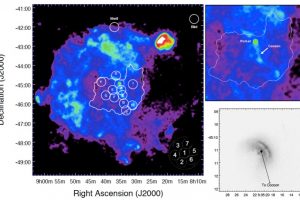Recently published on ApJ the study “Investigating the Structure of Vela X” of P. Slane (CfA) on the morphology of the Vela supernova remnant

What remains after a supernova explosion, which is among the most energetic phenomena in the Universe, is an expanding cloud interacting with the surrounding interstellar medium (the “supernova remnants”) and a compact object produced by the contraction of the nucleus of the progenitor star. Given its proximity to the Sun (“only” 945 light years), the Vela supernova remnant is one of the best studied. This remnant is located in the Vela constellation and it covers a large area of the sky with a diameter of about 6 degrees.
In radio observations, the Vela supernova remnant shows a thin shell with a density of about 1 particle for cm3. This shell is created by the shock produced by the compression of the surrounding cloud after the impact of the high-velocity expanding supernova ejecta. This compression also creates a reverse shock inside the remnant shell. Inside the shell it has also been discovered a pulsar wind nebula, which is a nebula surrounding and powered by the pulsar at the center of the remnant. This pulsar rotates with a period of 89.3 milliseconds, emits a collimated jet and it moves with a velocity of 80 km/sec in the direction of the jet. The Vela supernova remnant has been also the subject of several studies of astronomers of the Astronomical Observatory of Palermo, focused on the bow shocks along and outside the shell, with temperature of 1-6 million degrees, and the shock regions between the shell and the surrounding cloud.
In the study “Investigating the Structure of Vela X” of P. Slane (Harvard-Smithsonian Center for Astrophysics), recently appeared on The Astrophysical Journal, the complex morphology of the Vela supernova remnant is studied by analysing long (more than 103 hours) new observations in X-rays with the ESA satellite XMM-Newton and an archival X-ray observation of about 6 hours made with the NASA satellite Chandra. Together with these observations, the authors developed a hydrodynamical simulation aimed at understanding the properties of “the cocoon”, which is an X-ray bright nebula just 45 arc minutes southward the pulsar. This detailed analysis revealed that the structure of the remnant is due to the asymmetric destruction of the pulsar wind nebula due to the reverse shock. This asymmetry is due to the shape of the surrounding cloud. The authors have also analysed the chemical abundances, temperature, and emission mechanisms in several parts of the remnant. The astronomers M. Miceli e F. Bocchino of the Astronomical Observatory of Palermo are coauthors of the study.
The figure (link) shows an X-ray image of the Vela supernova remnant, with marked the XMM fields, the position of the pulsar, the pulsar wind nebula, and the cocoon.
of Mario Giuseppe Guarcello ( follow mguarce)
